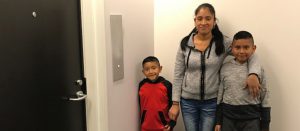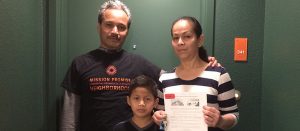Co-authored by:
by Director, Mission Promise Neighborhood Richard Raya
MEDA CEO Luis Granados
(NOTE: Read eight-page report on which this blog is based here.)
Asset building is in MEDA’s organizational DNA — and we’re proud that it’s part of our origin story, which began 46 years ago.
But our future is in collective impact with partners.
To resist and, ultimately, reverse the tidal wave of gentrification in San Francisco, MEDA moved beyond providing direct services and added an equity lens that focused on placekeeping for a community of color.
Pivoting to reflect new challenges
In 2012, the U.S. Department of Education awarded a five-year, $30 million Mission Promise Neighborhood (MPN) grant to MEDA so that it could work with 20 community partners to close the academic achievement gap for Latino students in San Francisco’s Mission District. As a result of becoming a backbone organization for this community-wide collective-impact initiative, MEDA began to double in size. Our nonprofit rapidly pivoted from being a direct-services provider to tackling community-development work as a means to proactively responding to the pressures facing the community, from rising income inequality to rapid gentrification to anti-immigrant policies.
For students to succeed, MEDA’s premise was that their families needed to have the tools to move out of poverty, complemented by affordable places to live and the fostering of political power to affect systems change.
The strategy also called for the array of community organizations providing support services in the neighborhood to band together, so that the scale of the solution began to match the scale of the problem.
This pivot in work led to the creation of:
The MEDA Community Real Estate team, which is preserving and producing almost 1,200 units of affordable housing in the Mission, in just five years since the program’s inception;
Permanently affordable commercial spaces for nonprofits and community-serving retail in the Mission, with 100,000 square feet to date;
Fondo Adelante, a small-business lending arm that is now a Community Development Financial Institution (CDFI), having in five years disbursed $2.5 million to small-business owners unable to access capital from traditional lenders;
Mission Adelante, a 501 (c)(4) advocacy affiliate of MEDA able to endorse or oppose candidates based on whether they have our community’s best interests at heart;
The California Promise Neighborhoods Network (CPNN) to build the impact of Promise Neighborhoods statewide; and
Leadership development and advocacy opportunities, resulting in parents organizing for political power for systems change, such as the need for community-centered schools, more City funding for affordable housing and limits on market-rate development in the Mission.
Where we are now: A focus on MPN accomplishments
To close the achievement gap for Latino students in the Mission, 20 partners agreed to a cradle-to-career continuum of wraparound services, a common agenda and shared measurement. Based on the theory that economic stability for families will lead to improved outcomes in school, this two-generation approach now serves families at nine K-12 public schools, three early learning centers and 11 family child care providers — connecting families to services, supporting students and guardians. Results-Based Accountability is collectively used to define and measure outcomes.
The scale of this collective impact initiative is unprecedented:
- 20,873 individuals served across all MPN programs since 2013.
- 9,893 below-market-rate (BMR) housing applications completed for 2,850 families since 2015.
- More than 6,458 referrals across the partner network since 2014, connecting families to jobs, health care, legal services and more.
The results have been promising indeed:
- Families reporting a medical home for children age 0-5 increased from 61 percent in 2016 to 80 percent in 2018.
- Preschool slots are now available for 100 percent of subsidy-eligible children in the Mission.
- 5-year olds who tested as Kinder-ready increased from 25 percent in 2015 to 45 percent in 2018.
- Students testing at or above grade-level in Eighth-Grade Math increased from 30.2 percent in 2015 to 41.8 percent in 2018.
- Students testing at or above grade-level in Eighth-Grade English Language Arts increased from 22.1 percent in 2013 to 36.2 percent in 2018.
- High school graduation rates at target high school increased from 68 percent in 2012 to 89 percent in 2018, exceeding the overall district rate.
Our opportunity
MEDA, with its new lines of work, and service-provider partners in the Mission have invested in aligning their work around a common set of goals, and that collective work is now bearing fruit – in improved outcomes for students and families, as well as in greater capacity for organizations on the ground. We have an opportunity to leverage what we have learned, and the momentum gained, to support families who are vulnerable to the continuing displacement pressures during this housing crisis and are under increasing pressure from anti-immigrant policies by the federal government.
But the funding for much of this infrastructure is set to end in less than a year.
The risk to or community
MPN funding ends June 30, 2020, when the current federal grant sunsets. The California Promise Neighborhoods Act of 2019 (SB 686), which MPN families helped to create and champion at the capitol in Sacramento, would create a new program to award competitive grants to 20 Promise Neighborhoods across the state. The bill has been approved by the full Senate and the Assembly Education Committee, but is currently being held until next year, at the Governor’s request. If this bill is successful and approved in July 2020, the state funding could eventually help MPN; however, the funding would be too late to cover MPN’s operating costs between July 1, 2020 and time to full implementation of the new grant program.
We are now seeking both stop-gap and ongoing funding from alternative sources. MPN partners have invested in building infrastructure that makes the alignment of our work possible. Losing funding means not just losing valuable services to students and families in the Mission, it also means the loss of the multiplier effect of many organizations complementing one another’s strengths during a time when they are needed the most.
How the money is spent
It costs $3.5 million per year to operate MPN. The majority of the funding is allocated to community partners (43 percent) and staffing the backbone infrastructure (43 percent). The loss of this infrastructure at this moment in time would have a devastating impact on the community’s families, schools and integrated network of service providers.
Here is how the majority of monies are allocated:
MPN PARTNERS
MPN-Funded: $1.5M
Felton Institute
Good Samaritan Family Resource Center Homeless Prenatal
Instituto Familiar de la Raza
Jamestown Community Center
La Raza Centro Legal
Mission Graduates
Mission Neighborhood Centers, Inc. Mission Neighborhood Health Center Nurse-Midwives of SFZGH
Parents for Public Schools
Seven Teepees
SFUSD—Early Education Department Support for Families
Tandem, Partners in Early Learning
YMCA Urban Services
Backbone Support Personnel: $1.5M
Promise Neighborhood Director
Associate Director
K-12 Program Manager
Early Learning Program Manager
Family Support Program Manager School-Based K-12 Family Success Coaches (8) Early Learning Family Success Coaches (3) Administrative Coordinator
Institutional Partners
Children’s Council of San Francisco
Department of Children, Youth and Their Families
First 5 San Francisco
San Francisco Department of Public Health
San Francisco Mayor’s Office of Housing & Community Development
San Francisco Office of Early Care and Education
San Francisco Office of Economic and Workforce Development
San Francisco Unified School District San Francisco Office of the Mayor
Conclusion
We must keep this momentum going as an anti-poverty strategy. Data sharing, collaboration, accountability to results: Promise Neighborhoods are the embodiment of what we call “good government.” It’s time for this type of initiative to move beyond being simply a boutique operation for select communities, and for it to become the normal way that government delivers services and strengthens underserved communities. As we all prepare for the biggest election of our lifetime in 2020, we should highlight the need for a more-just society.
Now is the time for bold equity initiatives — based on proven models.

 San Francisco native Alyssa P. proudly tells of the fact that she grew up in the Mission, ZIP code 94110 — the third generation of her family to do so. Some relatives were fishermen at the Wharf way back when, all coming home to the Mission each night.
San Francisco native Alyssa P. proudly tells of the fact that she grew up in the Mission, ZIP code 94110 — the third generation of her family to do so. Some relatives were fishermen at the Wharf way back when, all coming home to the Mission each night. MEDA and Mission Promise Neighborhood are fulfilling our vision by keeping families in San Francisco via connections to viable options for stable and affordable housing. We are solving the affordable-housing crisis through collective solutions. In addition to connecting families to eviction-protection services and the below-market-rate (BMR) apartment lottery, Mission Promise Neighborhood Family Success Coaches connect families to affordable housing that MEDA is purchasing through the City of San Francisco’s innovative
MEDA and Mission Promise Neighborhood are fulfilling our vision by keeping families in San Francisco via connections to viable options for stable and affordable housing. We are solving the affordable-housing crisis through collective solutions. In addition to connecting families to eviction-protection services and the below-market-rate (BMR) apartment lottery, Mission Promise Neighborhood Family Success Coaches connect families to affordable housing that MEDA is purchasing through the City of San Francisco’s innovative  “Our bathroom is larger than the one room my two children and I used to share,” says a thankful Juana Martinez of her two-bedroom apartment at brand-new FIVE 88 in San Francisco’s burgeoning Mission Bay.
“Our bathroom is larger than the one room my two children and I used to share,” says a thankful Juana Martinez of her two-bedroom apartment at brand-new FIVE 88 in San Francisco’s burgeoning Mission Bay.


